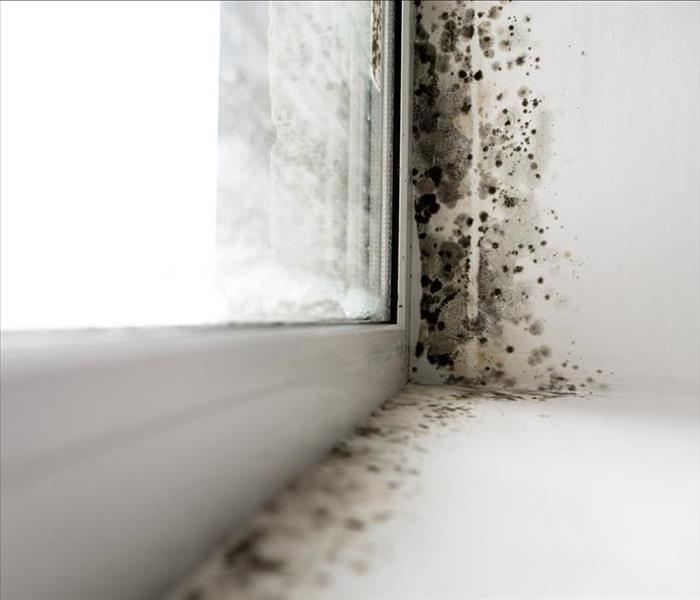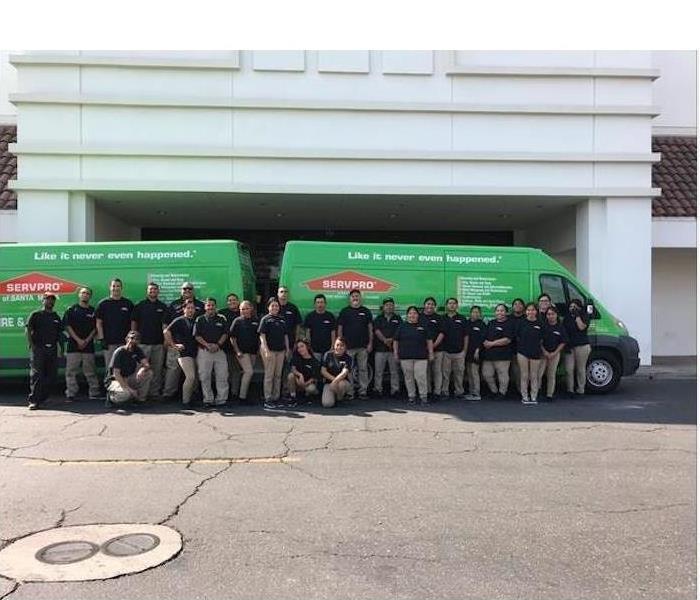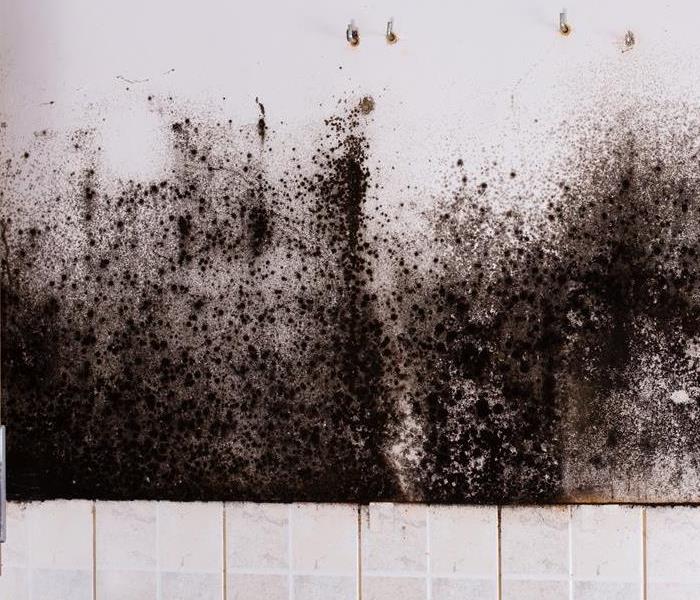Recent Mold Remediation Posts
Three Signs That Mold May Be Present in the Household
5/24/2019 (Permalink)
 Mildew is visible
Mildew is visible
Three Signs That There May be Mold in a Residence
Recognizing the signs of mold contamination in a residence in Santa Maria, CA is very important. If mildew is indeed found at a home, it is important for a homeowner to contact professionals who conduct mold remediation. Here are three signs that may suggest that there may be mold in a residence.
1. The Mildew Is Visible
One of the most obvious indications of mold and mildew is that it is clearly visible. Therefore, it’s a good idea to constantly keep an eye out for any signs of mold and mildew around the house. While mold spores may grow on many surfaces and in numerous areas of a household, the bathroom is often a place where mold and mildew are regularly found. This is because mold thrives in damp, wet environments, and the bathroom is typically a prime area for this sort of setting. Be sure to check to see if the shower or the sink area (including under the sink) have any signs of mold contamination and consider calling professionals to aid in removing the mold if it is found. (Don’t forget to check in other areas where water or sinks are in the home, such as the kitchen, for example!).
2. There Is a Stuffy Smell
Mold may have an odor associated with it that can smell musty or stuffy. While there may be other reasons for odors in the household that are not related to mildew, it may be a good idea to have a professional rule out any mold that could be the cause of the smell.
3. The Environment in the House Feels Very Humid
As mentioned above, mold and mildew grow in damp and humid areas. If areas inside a residence feel very damp, it is a possibility that mold may be growing there. It may be a good idea to rule out any mold contamination in a residence that feels particularly humid. A thorough search for mold by experts may help identify and locate any issues with mold in the home.
Understanding Residential Fungus: The Key Differences Between Mold and Mildew
1/22/2019 (Permalink)
 Contact SERVPRO of Santa Maria for professional assistance
Contact SERVPRO of Santa Maria for professional assistance
Differences Between Mold and Mildew
Mildew and mold damage are two very different sides of the same fungus coin. One is repaired easily without the need for professional intervention while the other is likely more invasive and requires removal experts. Understanding the differences between mold and mildew will help you determine the necessary course of action.
1. Different Colors
Mildew growth is not as vibrant as mold and is likely varying shades of gray and white. Mold is more colorful, typically appearing as either green or black. While there is a tendency to assume mold is black mold because of its color, that is not often the case; there are special tests that need to be performed to determine mold type.
2. Varying Textures
Mold damage is typically identified by its fuzzy texture and its nature to seep into porous materials. Mildew is generally flat and may even resemble a stain or slight discoloration of the material it is found on.
3. Diverse Infestation Methods
Mold growth will typically start near a cool, damp source and branch out, and it can begin colonizing with 12 days of the initial growth. Mildew is not as aggressive, but it can also spread fairly quickly. Mildew, however, will typically stay localized while mold will spread out in every direction, even jumping areas through ventilation and ductwork.
4. Various Cleaning Methods and Remedies
While mildew is a surface fungus that does not penetrate deep within materials, mold is more aggressive. Mold begins deep within, and when it appears on the surface, it likely means a bigger problem. Mold will probably require a mold remediation specialist in the Santa Maria, CA, area, but mildew can be remedied with many store-bought cleaners.
Mildew and mold damage are similar yet starkly different. Mildew is remedied quickly with inexpensive cleaners, but mold is persistent, and it lingers in crevices and cavities which is why mold often requires professional assistance.
How To Stop Black Mold in Its Tracks
9/14/2018 (Permalink)
 Black mold damage in Santa Maria, CA
Black mold damage in Santa Maria, CA
When mold strikes, the last thing you want to do is spread it throughout your Santa Maria, CA, home. Even though mold loves moisture and typically festers in wet, warm areas, spores from spreading mold can easily travel from one room to another via air movement. There are certain places and things in your home that should be frequently checked and thoroughly cleaned to keep mold at bay. These include the following:
- Moldings around windows and doors
- Musty basements
- Humidifiers
- Bathroom tiles
- Surfaces surrounding air conditioners
- Refrigerator door seals
- Shower stalls and curtains
Taking care of moisture issues is one of the best ways to prevent mold from starting and growing. If you’re past the prevention stage, it is vital that you stop spreading mold at the first sign of a problem with professional mold remediation.
Leave Black Mold to the Professionals
While DIY may be the way to go with some home projects, getting rid of a mold infestation isn’t one of them. Trying to take care of such a tricky substance by yourself often does more harm than good since the spores that move through the air are virtually undetectable by the naked eye. Mold remediation companies are thoroughly trained to prevent the spreading of black mold. They have both the tools and the skills to get your home back to normal from start to finish. Some of these steps include the following:
- Performing initial inspections
- Filtering the air in your home
- Containing the mold
- Removing damaged and diseased materials
- Repairing and restoring your home to its original condition
Because mold spores move quickly through the air and multiply on almost any surface they land on, it’s important that you squash the spreading mold in your Santa Maria, CA, home quickly and meticulously. Don’t let the thought of mold stop you in your tracks. With mold remediation, you can have your home and peace of mind back in no time.
How Mold Remediation Works
12/16/2017 (Permalink)
How Mold Remediation Works
The discovery of black mold can be terrifying for any homeowner, as it carries significant consequences such as decreased property value. If you think you’ve developed a colony of spore growth in an area of your home in Santa Maria, California it’s crucial to get help from a professional mold remediation service before it spreads throughout the building. Here’s what you can expect to happen during a typical mold cleanup project.
Inspection
The first step in the process is to have an experienced professional inspect the area and determine the type of growth. There are many different types of spores, and it takes a trained eye to figure out if it’s black mold or something else.
Containment
Once the technician makes a determination, the next step is to contain the growth so it doesn’t spread to other parts of the house. This can be accomplished in a few different ways:
Negative air chambers
Physical barriers
Air filtration units
Removal of Untreatable Surfaces
While some surfaces can be cleaned, there are porous materials that will still harbor spores despite your best efforts. As part of the remediation process, technicians will likely remove the following:
Carpeting
Drywall
Insulation
Mattresses
Cleaning and Restoration
With permeable surfaces removed, efforts can transition to cleanup and restoration in the affected area. Depending on the type of mold, technicians will use a variety of different techniques to eradicate the infestation and remove unpleasant odors. Once cleaning is complete, your contractor will finish drying the area and replace the surfaces removed over the course of the project.
Prevention Is Key
Now that the project is complete, it’s important to take steps to prevent black mold from returning to your home. Even something as simple as the installation of a dehumidifier could be enough to keep you from having to endure the mold cleanup process again. While upgrades such as basement waterproofing and French drains might seem excessive, they’re much better than regular appointments for mold remediation. Visit http://www.SERVPROsantamaria.com for more information on mold.
In Santa Maria, mold can spread through a home in as little as 48 hours.
7/21/2017 (Permalink)
Microscopic mold spores naturally occur almost everywhere, both outdoors and indoors. This makes it impossible to remove all mold from a home or business. Therefore, mold remediation reduces the mold spore count back to its natural or baseline level. Some restoration businesses advertise "mold removal" and even guarantee to remove all mold, which is a fallacy. Consider the following mold facts:
- Mold is present almost everywhere, indoors and outdoors.
- Mold spores are microscopic and float along in the air and may enter your home through windows, doors, or AC/heating systems or even hitch a ride indoors on your clothing or a pet.
- Mold spores thrive on moisture. Mold spores can quickly grow into colonies when exposed to water. These colonies may produce allergens and irritants.
- Before mold remediation can begin, any sources of water or moisture must be addressed. Otherwise, the mold may return.
- Mold often produces a strong, musty odor and can lead you to possible mold problem areas.
- Even higher-than-normal indoor humidity can support mold growth. Keep indoor humidity below 45 percent.
If your home or business has a mold problem, we can inspect and assess your property and use our specialized training, equipment, and expertise to remediate your mold infestation.
If You See Signs of Mold, Call Us Today at 805-922-5457





 24/7 Emergency Service
24/7 Emergency Service


